Are you looking for the best glue for plastic, metal, or resin miniatures? An essential tool for any miniature hobbyist is a good glue. How else do you assemble and glue Warhammer miniature kits? For a hobbyists working with miniatures, scale models, and even 3D prints, a good glue needs to be strong, reliable, and easy to apply. A glue needs to be convenient and work across a variety of materials.
In this article, I share everything you need to know about glues and adhesives for assembling miniatures and model kits. Whether your parts are made of plastic, metal, or resin, there is a best glue to do the job.
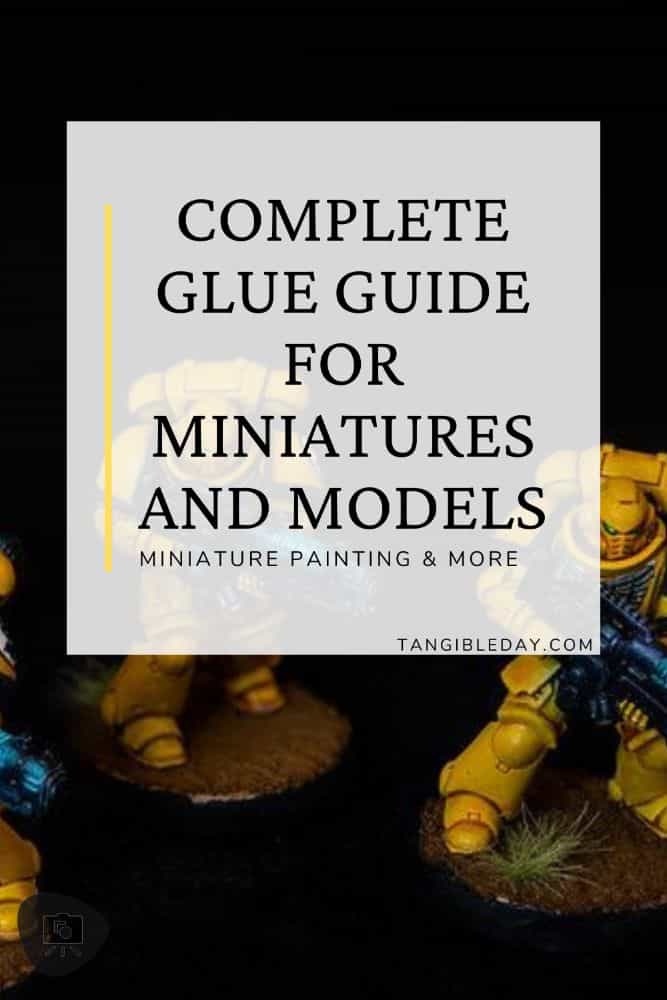
Key TAKEAWAY
- For plastic model kits, super glue or plastic cement model glue is best, with plastic modeling cement providing a permanent bond for plastic miniature parts.
- Metal miniatures are best assembled with super glue (aka cyanoacrylate). But for very large parts, two-part epoxy is stronger and more durable.
- For resin miniatures, super glue is usually effective; however, as with metal parts, two-part epoxy may provide a stronger bond. It’s important to wash resin before gluing to remove residual lubrication left behind from the cast-molding process. Small resin parts can be more joined by pinning and applying super glue inside the joint.
- For 3D printed models made of PLA, ABS plastics, or cured resin, any super glue works well.
- In general, the choice of glue depends on the material, the size and weight of the parts, and the stress the model will endure during handling.
Read on for more information about my recommendations for the best glues for miniatures and models.
Glue Guide for Miniatures and Models
Best Glue for Plastic, Resin, or Metal Miniatures?
Some of the more impressive miniatures are made by highly experienced, well-known game companies, such as Games Workshop (Citadel), Privateer Press, and Corvus Belli. There are many other game companies, including board game publishers who have established miniature lines. In general, these miniatures come in kits that need to be assembled.
READ MORE: GAP FILLERS AND WHY YOU NEED THEM
Finding the best glue to help with this aspect of the gaming and modeling hobby is part of the challenge. The components for these kits might be made of plastic, pewter (also known as white metal), or resin. In some cases, you might purchase a kit that contains parts from several different materials.
What is the best glue for each hobby kit material?
“Just use super glue!”
But…
Sometimes it won’t work.
Or, you find that over time little bits fall off your mini.
This is especially true if you are a tabletop gamer. You’re carrying your models around, and bustling them around a table battlefield or board.
Oops, an arm falls off.
That axe you tried for hours to keep in place, pops off.
Sure, you pinned your model. But, is that horse’s tail spinning in circles like a flag?

Best Glue for 3D Prints (PLA or Resin)
In some cases, the models I’ve had to glue together were 3D printed.
3D printed models are usually made of PLA or ABS plastics. In the more sophisticated DLP or SLA 3D printers, the parts are made of cured resin.
Still, isn’t super glue enough?
I know most of you already go by the standard super glue. Good choice. Is super glue the best choice of glue? Indeed, it’s what I use most of the time. But, there are so many types of super glues. Some super glues are better than others.
There are super glues in gel form, or super-thin form that runs quick. Some cure and form a bond faster than other glues. Others are really useful for filling gaps between surfaces. So, in fact, there is no best super glue for miniatures.
The best super glue is the one that does what you need. And, if you think about it, there are lot of glue options out there.
I’ve tried a lot of them!
Even this adhesive (see Bondic), isn’t actually an adhesive (according to the company who makes it). UV curable resin “adhesives” are great for random household stuff. But, in my experience, they are limited for the miniature hobbyist. They break off easily, as they don’t actually form a strong bond with plastic or metal surfaces. And, it’s pricey.

Ultimately, for 3D prints, the best glue is any super glue. They all work great for gluing 3D printed parts, including those printed in PLA, ABS, and TPU.
What Should I Know About Glues?
I’m not a chemist, but I do a lot of research. I also experiment, a lot!
I’m in the hobby for fun, so part of that is the thrill of discovering new things. What works? What doesn’t? See other things I’ve tried and learned about whether a wet palette is worth the hassle, or why a hair dryer is an important tool for miniature painters.
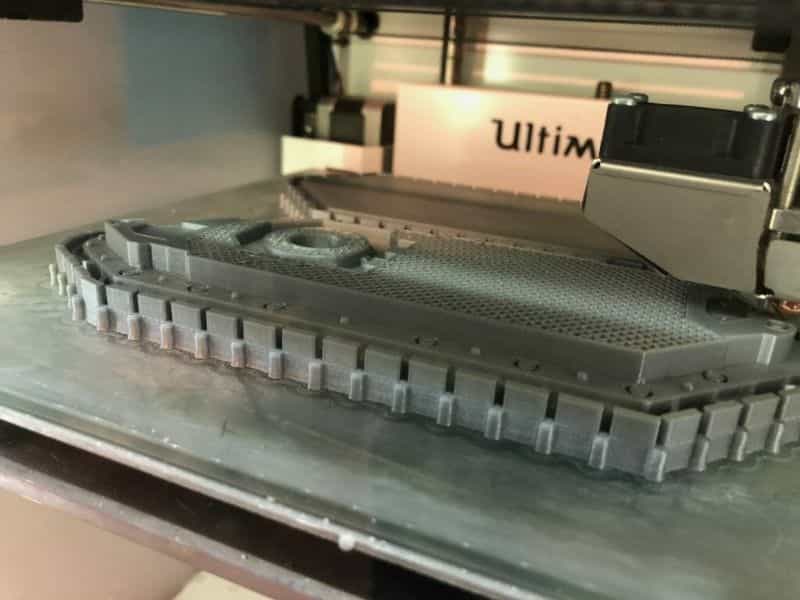
READ MORE: BEST GLUE FOR BASING MINIATURES
As a commissioned artist for miniatures, I’ve had to assemble all kinds of models. I’ve had to learn through experience what was the best glues to use for assembling miniatures, crafting terrain pieces, and constructing 3D printed parts into a complete model.
Some glues are gels, runny liquids, or sprays (just don’t use it for hair). Depending on your project, you’ll want to use a particular kind of glue. Read on for more details about the best glues for your hobby project.

Best Glue for Plastic Models and Miniatures?
Super glue is the best type of glue for plastic models. This is especially true for polyurethane-based plastic kits, such as for Games Workshop gaming miniatures, e.g., Warhammer 40k, Age of Sigmar, Dungeon and Dragons or other RPG miniatures, Wizkids minis, and most scale model kits that come on plastic sprues, e.g., model cars, train and airplane models.
Super glue works fast and bonds well to plastic. For scale model kits made of polystyrene or polyurethane plastic, super glue works great. Just be careful of clear plastic parts, like windows. Super glue will frost clear acrylic and plastic parts and make them appear cloudy. To avoid the clouding effect on clear plastic parts, I suggest using a plastic cement model glue (below).
If you’re looking for a permanent bond between plastic parts for miniatures, then plastic modeling cement will be the best glue for plastics. Plastic cement has an active chemical solvent (usually toluene) that will first dissolve plastic upon application, then harden the “molten” plastic back together, permanently fusing plastic parts together. As a consequence, plastic cement is useless for assembling anything other than plastic.
Plastic cement model glues will not work on metal or resin miniature parts. On the other hand, for plastics they are fantastic, especially if you want to glue clear plastic pieces, e.g., windows, cockpits, and avoid the frosting you would get with super glues and cyanoacrylates (CYA).
Best Glue for Metal Miniatures?
The best glue for metal miniatures is super glue. For most metal miniatures or models, pewter is the metal material. Pewter is a soft, malleable metal alloy (e.g., a mixture) of mostly tin (up to 99%) mixed with other metals. The best way to glue pewter metal miniatures is with super glue, especially small parts. However, you may find that heavy and larger pieces of metal may require pinning (e.g., drilling and inserting a “pin” to strengthen a joint), or a stronger adhesive.
The best glue or adhesive for bonding larger metal pieces is with two-part epoxy. Epoxy is a resin that consists of two parts that must be mixed together. One part is the bonding agent, and the other part is the catalyst that triggers the curing process (for hardening the epoxy resin). As a metal glue, I find epoxy to be second to none when it comes to comprehensive strength.
Epoxy is a very strong adhesive. When in doubt, epoxy will do the job where other glues will fail. The limitation of epoxy is that is takes more technical skill to use it, and a bit more time for the resin to harden. You may have to clamp or hold parts together while an epoxy resin cures.
Best Glue for Resin Miniatures?
The best glue for resin miniatures is super glue. Super glue is fast and bonds well on most surfaces, including resin miniatures. The flexible nature of resin, however, does make super glue less useful on thin or small resin parts. For a strong bond with resin miniatures, two-part epoxy adhesive will be the better choice. Epoxy, however, only works if there is sufficient bonding surface area for the epoxy to bind.
Resin is an odd beast for miniatures. Resin material is often flexible and porous (has many tiny holes in it). This makes resin both easy and hard to glue together. Additionally, resin is cast from molds. For resin parts to come out of molds more easily, a lubricant is used inside the mold. Residual lubrication on the resin parts makes them repel many glues until that lubrication is washed off. As such, before gluing resin parts together, wash them first.
If you’re looking to join small resin parts, try pinning and applying super glue. You’ll have a stronger joint.
For more details about different glues for miniatures and models, continue reading below!
Three Types of glues for Miniatures and Models
Different glues are better suited for different types of bonding projects. The type of glue you choose for your project will depend on what material the model is made out of, how complex or large the parts are, and how strong a bond should be expected to hold over time.
1. Cyanoacrylate (also known as “Super Glue” or “Crazy Glue”)
Pros
- Versatile
- Easy to use
- Cheap
- Fast acting, almost instant bonds
- Works on any material
Cons
- Potentially harmful fumes
- Bonds skin and flesh
- May not work on “dry” surfaces or water repelling surfaces
- Glue bottles and tubes clog easily
2. Plastic model cement (or styrene cement)
Pros
- Best plastic glue for strength and durability
- Most effective agent for bonding styrene based plastic miniatures
- Fuses plastic surfaces permanently (almost unbreakable)
- Inexpensive
- Well-respected in the scale modeling world
- Easy to find in most hobby stores
Cons
- Only works on styrene-based plastics (won’t work on resin, etc)
- Strong and harmful vapors
- Can be more technical to apply properly (i.e., less is more approach)
- Cure time depends on many factors
3. Two-part epoxy
Pros
- Strong bonding properties
- Works on almost any surface
- Best glue or adhesive for long term durability
- Chemically resilient to most solvents
- Longer working time than super glue
- Low or no odor/vapors
Cons
- Can be more expensive
- More complicated to apply to models
- Requires proper ratio mixing to cure
- May not be ideal for small contact surfaces (i.e., small miniature parts)
Everyone has their opinion on what is the best product for their needs. I hope some of this information is useful for helping you decide on the best way to assemble your models.

MORE: PAINTING HANDLE WITH ARTICULATING ARMS MAY HELP YOU GLUE MINIATURES
Professional Tips for Using Super Glue, Plastic Cement, and Two-Part Epoxy
Cyanoacrylate or “Super Glue”
Super glue, crazy glue, or just plain cyanoacrylate is the most versatile glue. It is the best glue for new modelers because super glue works on almost every material that a miniature hobbyist uses.
If you’re a veteran hobbyist, then you’ve noticed that CA sticks really well to your skin!
Quick tip: To remove super glue from your skin, you can use acetone. Acetone breaks the bonds in cured cyanoacrylate. Acetone is found in nail polish removers.
Unlike the white (PVA) glues, which are water-based glues we used in school arts and crafts, cyanoacrylate is a form of acrylic resin. The active ingredient in super glue is cyanoacrylate, which transforms from a liquid-form into a hardened plastic acrylic-state after curing.
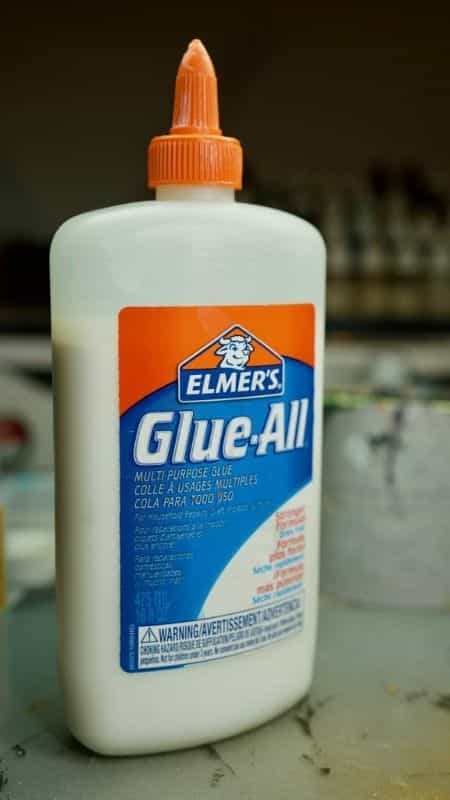
Interestingly, cyanoacrylate doesn’t “dry” like other glues. That is, this kind of glue needs some water moisture to bond to a surface. This might be why when you apply super glue to a very dry surface (like a pewter model) it might fail to harden into a bond.
If there is some water present, cyanoacrylate glue will very rapidly cure and harden.
One trick that I’ve used to accelerate the bonding of super glue for miniatures is to add a little saliva. This method came in especially useful when I was rushed for time during an convention event.
MORE: OTHER SALIVA (SPIT) HACKS FOR MINIATURE HOBBIES
I know it’s gross, but it’s just using science to work in our hobby. There are super glue accelerators.
Two-Part Epoxy
Despite the versatility of Super Glues (cyanoacrylate), there are times when you can’t use this adhesive.
In my case, it’s because there isn’t enough ambient moisture on the miniature (e.g., some materials repel water). Or, in some large models that I work with, I’m not sure the super glue has enough strength to remain durable over time.
So, when I’m looking for a stronger bond that can endure some of the stresses imposed on a model, I turn to epoxies. Epoxy based adhesives are the best glues for when you need bonds to withstand breaking force over a long period of time. Even when conditions are poor, such as extreme heat or cold temperature, epoxies can deal with it.
Although a bit more complicated to use, I love this stuff.
Epoxies are suitable for a wide variety of materials. They are just as versatile as super glue. However, because they require the mixing of two parts to begin curing, epoxies can be more complicated to use. Epoxy is best for when you have a plan. Do you know what needs bonding? And, can you you hold those pieces together for sometime while the epoxy cures?
Epoxies have variable cure times, which means you won’t get the instant bonding you may achieve with cyanoacrylate super glue. Choosing the best cure time is a key part of deciding which epoxy to use.
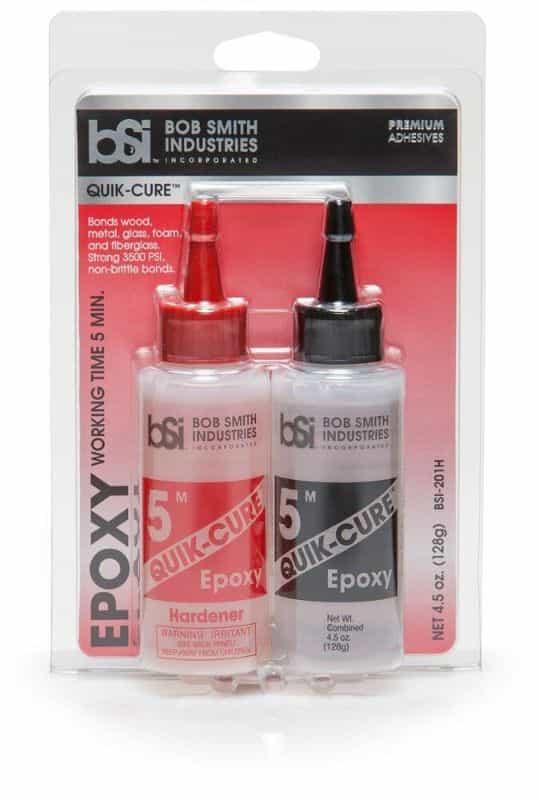
Two-part epoxies bond many kinds of materials such as most metals, including pewter, plastics, and even wood. Unlike super glue, epoxies have better chemical and water resistance that makes them perfect for outdoor applications.
Epoxy is a great construction adhesive for a reason and can work well for gluing miniatures. Of course, I’ve never left a model outside, but I have spilled a beverage or two on models.
Epoxies should be your “go-to” best adhesive when you really don’t want the model to fall apart.
Some of the other benefits of two-part epoxies are that they don’t have the powerful odors of cyanoacrylate super glues. In general, they are safer to use in a smaller environment.
Because their curing process is through chemical mixing of two parts, epoxies are easily cleaned up from any surface, as long as it hasn’t fully cured. This means that epoxy on your skin is much easier to remove.
Quick tip: Uncured epoxy is washed off surfaces with isopropyl alcohol (“rubbing alcohol”).
Another reason I like using epoxies, is that you can predict when the product will bond. Detailed below, the epoxy I recommend cures in 5 minutes following mixing. This allows you time to apply it where you want on your miniatures. Additionally, you’ll know how long to keep the surfaces you want bonded together before you can let go.
Plastic Model Cement
Many of the model kits that we assemble are made of plastic.
Games Workshop models, for example, make most of their miniature line with an injection molded plastics. They sell the “sprue” kits that we cut the pieces from, and assemble into the completed mini.
A lot of scale models of military vehicles, such as planes and tanks, are also created this way. Many of Tamiya’s kits and the Gunpla models are made of styrene-based plastics.
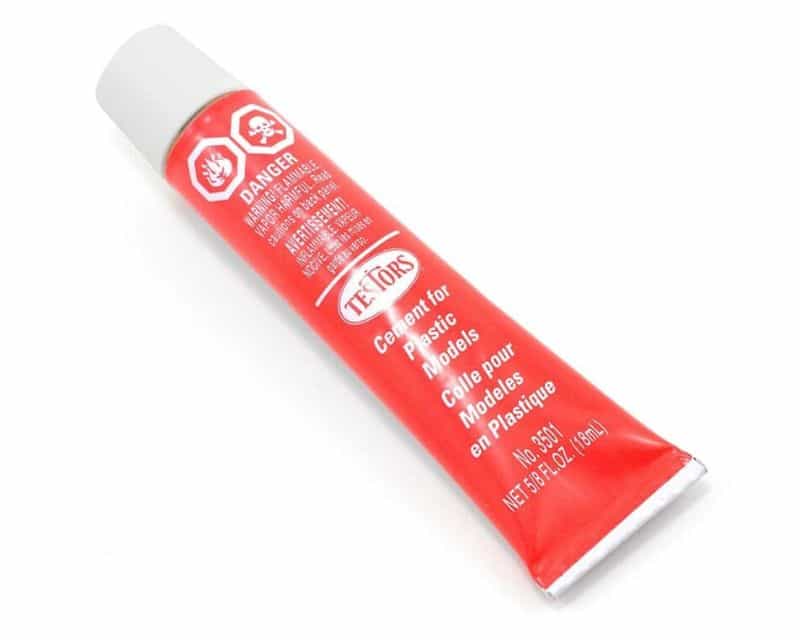
This is why plastic model cement is so popular. It is the best plastic glue to use with plastic kits. Note: plastic cement isn’t a typical glue. More about this below.
Plastic cement is useful for scratch building (I’ve written a little about scratch building and 3D printing here). If you’re a scratch builder, then you should probably consider having plastic cement in your gluing arsenal.
In general, plastic model cement is one of the most respected adhesives in the model-making and miniature hobby world.
Why is that?
Plastic cement work through a unique chemical process whereby the glue melts the two separate plastic surfaces. As the glue cures, the melted plastic solidifies into a single plastic membranous bond.
Essentially, plastic model cement “fuses” plastic together into a single part.
It is a permanent bond.
For some of the more experienced modelers, you may have noticed that Super Glues can create a “frost” over parts. This is especially troublesome for clear parts, like windows for cockpits.
Plastic cement doesn’t have this problem, and are therefore ideal for when you want to glue miniatures that have clear parts that you want to have stay clear. As a canopy glue for model aircraft, plastic cement has stood the test of time and is still one of the most popular glues among hobbyists.
This is the best adhesive for gluing clear parts (Micro Kristal Klear).
Internet Research
Because plastic cement works by dissolving the plastic surfaces, it is better to use small amounts of this glue. Otherwise, you risk “melting” your plastic pieces too far, creating gaps or uneven joints in your minis.
RELATED: COMBINE PLASTIC CEMENT AND OLD PLASTIC KITS TO MAKE “SPRUE GOO” MODEL GAP FILLER
Finally, note that these glues have strong odors with vapors that are harmful. Sure, if you’re “sniffer”, you’ll get a short-acting high, but it won’t be long before you’ll have a headache that never goes away. You should use these glues in a well-ventilated place.
Best Practice for Assembling Models and Miniatures with Glue
Tip #1 – For best results, you should “dry fit” model parts before applying glue
Dry fitting is the process of making sure separate parts fit together without gaps or seams. If you find your parts do not join together properly, e.g., unwanted gaps or joints, then you can use a file, sandpaper, or other tool to remove surface material to ensure a good fit. After applying glue, if small gaps remain, you can use an appropriate gap filler to smooth out any surface imperfections.
Tip #2 – Don’t use more glue than you need
More glue doesn’t mean a better or stronger bond between miniature parts. In fact, too much glue can make your job much harder. Excess super glue, for example, will distort the surfaces you’re joining and will make clean-up frustrating. This is especially important when working with plastic cement, as the “cement” will melt any plastic it touches. Too much plastic cement will dissolve your miniature pieces into molten plastic slag.
Tip #3 – Make sure your parts are clean before gluing
Remember to wash parts, at least with soap and water, for the strongest bond possible. Any residual oils from your fingers, the part molding process, or dust can significantly weaken any glue bond. If you’re looking for the most efficient way to wash your parts, you can try using an ultrasonic cleaner. Some ultrasonic cleaners heat up which speeds up the cleaning process, and work great for cleaning resin pieces, e.g., Forgeworld models, prior to gluing and assembly.
Tip #4 – Use an accelerant or clamp your parts together after applying glue.
The most frustrating part about gluing models together is when pieces won’t stay in the right place while you wait for glue to dry. You can speed up glue drying with an accelerant, such as zip kicker for super glue. To hold pieces together, there are several options that I’ve tried and work well. You can use a dab of Bondic UV curable resin to hold pieces together while another glue dries, or use a helping hand with spring-loaded clamps. You can also use a jig designed for assembling doll houses, miniatures, and scale model kits.
Recommended 10 Glues for Miniatures and Models
It’s a question I’ve asked myself several times over the years. What is the best glue for miniatures? What is the best glue for plastic models, or pewter miniatures? How about 3D printed parts?
I’ve spent a lot of time shopping online, art stores, and simply buying what I thought might work better. I love to figure things out by experimentation.
Here’s a list of 10 glues for miniatures and models:
Gorilla glue is the standard super glue that most people use at my local club. It is easy to find in most hardware or art stores. It comes in a small bottle with an easy to dispense tip. The glue is viscous, but flows enough to get it where you want it to. In my hands, the models I’ve used this super glue on have stayed together.
The bond is strong enough for me to handle the models while gaming, or for holding up fairly heavy pewter pieces. I personally don’t pin my models, so I’ve relied entirely on the strength of my glues.
If there was one drawback that bothers me with this glue, and most super glues in general, is that they tend to lose their “sticking” power as time goes on. After I’ve opened one of these glues and uncapped the bottle, there comes a point when the glue won’t cure.
The only way I’ve gotten around this is to use an accelerant like this.
Anyway, I usually have this glue on my desk within easy reach.
Other key features:
- No run control gel formula; great for use on vertical surfaces
- Impact tough: unique rubber particles increase impact resistance and strength
- Fast-setting: dries in 10-30 seconds, no clamping required
- Versatile: bonds plastic, wood, metal, ceramic, rubber, leather, paper and more
Early on when I started the hobby, a friend recommended this glue to me. It was available in my favorite local hobby shop, so I picked up a bottle. Apparently, its a super glue that helps fill gaps between the two surfaces your want to join. I’m not sure if the super glue expands as it cures, or if its because it flows through cracks. It does have a lower viscosity and thickness than other super glues I’ve used.
At the end of the day, it worked and joined pieces well. It also filled cracks and gaps in my models well.
The only issue I had was that because it was thinner, I ended up using the bottle faster. It flowed out easier and so I used more of it.
I generally don’t buy this kind of super glue anymore only because I’ve been trying to be judicious with my hobby budget. But, if you’re looking for something that comes out of the bottle without any hassle this is it!
Oh, lastly, because of either the formulation or how the bottle is designed, I haven’t had to unclog this super glue from its bottle. It keeps the flow going!
Other key features:
- Zap-A-Gap 1 oz
- Marketed as “The Only Total Adhesive System for All your Needs
- Multiple Sizes and Applications Available
3. Bob Smith Industries BSI-133H Insta-Cure+ Gap Filling Super Glue
(The Best Glue for Magnetizing Models)
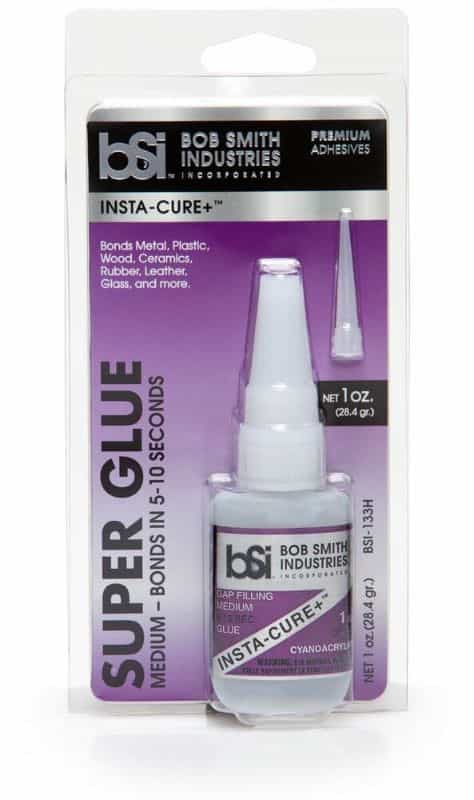
This is the best glue to use if you’re attaching magnets to your miniatures.
Magnetizing miniatures is a huge part of the hobby for many people who collect Games Workshop models. These miniatures come with different options for assembling a particular kit.
On a single vehicle chassis, for example, there might 4 or 5 different ways you can create your model’s outfit (e.g., kind of like dressing up a Barbie doll).
But, magnets tend to be a challenge to glue. Some of the stronger magnets can rip themselves out of their sockets without a strong glue holding them in.
I’ve heard from various places/vendors (source) that this BSI super glue is the most reliable and durable glue for attaching magnets to your minis. It probably works well for magnets because the glue tends to fill gaps really well. This increases the bonding surface area, which in turn improves the durability of the parts staying together.
In general, I’ve found BSI glues to be a premium hobby product. They are sort of expensive. But if you’re looking for something that will last and work well for magnetizing your miniatures, then this BSI super glue is the best glue for magnetizing your models.
Other key features:
- Insta-Cure+ is a higher viscosity CA for loose fitting joints in which the adhesive must bridge gaps
- Bonds Metal, Plastic, Wood, Ceramics, Rubber, Leather, Glass, and more
- Bonds in 5-10 Seconds
- Proud Sponsors of Wounded Warrior Project
4. Professional Grade Cyanoacrylate (CA) “Super Glue” by Glue Masters
(The Best Value Super Glue, My Favorite)
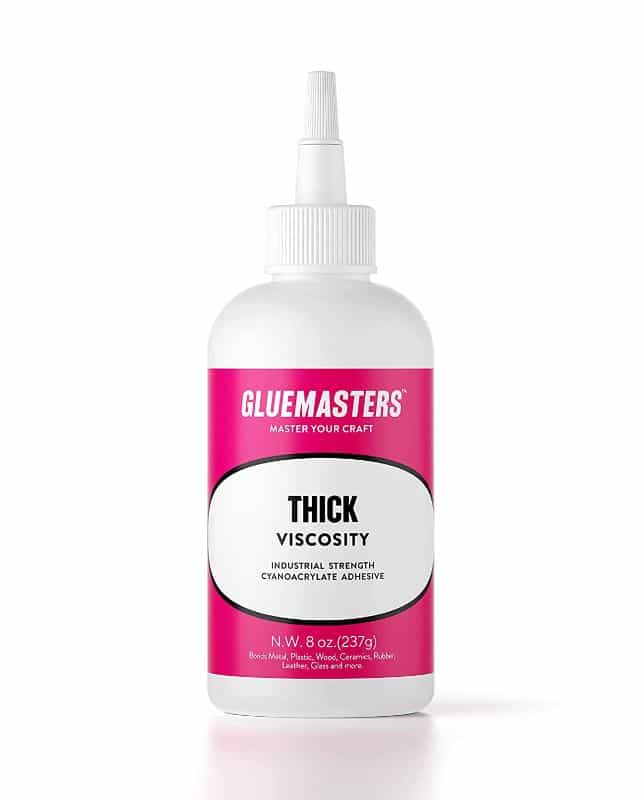
This is my favorite glue.
It’s weird because its the cyanoacrylate that no one really knows about. I stumbled on it during an online search for cost-effective bulk glue. A few YouTube channels showed this glue, and on a whim I purchased it. The volume to cost ratio is way better than its competitors, so why not?
Well, it’s simply awesome.
You get a ton of it (get the 8oz bottle). The thick viscosity is perfect for easy application on small miniature parts. It sticks where you want it, and cures up parts securely.
Although I didn’t know at the time, but the cap design is convienent. Don’t you hate it when your glues gum up the cap so badly that everything is clogged? Then, you need to pull out a needle or sharp object just to get your glue to flow again? Well, this cyanoacrylate comes in a bottle with a screw cap! It doesn’t clog! Yes, really. I wouldn’t say it if I didn’t actually use this stuff for along time without this surprising finding.
It’s the small things, isn’t it?
Bottom line: this is my favorite cyanoacrylate glue right now because of its cost, thick consistency (perfect for miniatures or modeling), and that bottle cap. So good. Get it, you won’t regret it. And if you do, it’s cheap (or on Amazon, just return it).
Other key features:
- Industrial strength Cyanoacrylate Resin with the strongest bond on the market for your money
- Settles in just under 50 seconds, this glue is the epitome of easy
- Builder’s first pick for a quality hold and a flow you can trust with those delicate planes, trains, and boats
- From building models to repairing old china, glass, wood, and more, this is the pick for general household repairs, carpentry and whatever else you need fixed.
I have two of these Citadel plastic glue bottle applicators. One opened, and another spare in its packaging in my drawer ready to go. The cement is easy to dispense from the bottle with its narrow dispensing nozzle. This is important because you don’t need a lot of plastic model cement for it to work.
As the plastic cement functions to “melt” or dissolve the plastic surfaces, it only takes a small bit. Because the chemical inside is a volatile solvent, it evaporates quickly, which also means your plastic parts bond fast. As a reliable plastic glue, this is awesome, as it dries quickly and permanently.
Because of the shape of the bottle, this particular brand of plastic cement allows you to sit it on the table at an angle without the cap on. This is probably the best reason to get this plastic model cement for your miniatures.
Glue applicator ergonomics, who would have thought?
You can leave the bottle uncapped as you work, without worrying about any of the glue seeping out onto your work surface (I hate that with the tube glues).
The cement is fairly thin with a medium viscosity. In general, it goes where you want it to. I can’t recommend this more.
Did I mention that I have a spare bottle just sitting in my drawer?
Other key features:
- This is a 0.7 Oz. Container of Games Workshop Citadel Plastic Glue (Thick)
- For polystyrene, acetate, plexiglas, lucite and most other plastics except vinyl, polyethylene, polypropylene and phenolics
- Precision applicator for precise application of cement
I tried it and loved how thin this glue is. It’s really runny. It’ll go where ever it can without you even trying to do anything. This is good and bad. Good, in that you can dab it on a surface, a very tine surface, and you’ll have plenty for it to function. Take a toothpick and dab that dot of cement where it needs to go. Capillary action will do the rest, pulling the thin superglue along fine edges, panel lines, and more.
This is also bad. It’ll smear everywhere if you’re not careful. In many other modelers’ opinions, this is the best glue for plastic miniatures, e.g., gunpla models.
Because plastic cement melts and dissolves most styrene based plastics, it’ll scar and abrade any plastic surface. In this case, if you wanted a smooth armor plate to stay that way, you better be sure not to have any plastic cement get on it.
This thin cement glue will make working with fine detailed parts you want to “stay clean” more challenging. So, with great benefits of this plastic cement (e.g., the thin easy to apply nature), you’ll need to wield greater control over it.
Other key features:
- Genuine Tamiya product
- 40ml container
- Brush applicator
The classic tube plastic glue. The red tubes that my generation used to assemble model kits. Testor’s makes everything for the bonafide miniature hobbyist and modeler. This is one of those staple products that has been around forever.
I love this stuff.
It’s a thick, viscous plastic cement that comes out of a toothpaste-like tube. It lasts a long time, meaning that one tube will probably be all you need for many years of modeling and kit building.
Make sure you have some toothpicks or other applicator ready to control where you want this gel-like glue to go. Sometimes it just won’t move around.
Things I’ve observed with this glue over the years is that it can get stringy if you use too much. Those strings of glue and get on plastic surfaces of your model and create unwanted melted bits. So, you do need to be careful of how you move it about your desk as it is applied.
The tube also seems to have the weird behavior of leaking glue out of the nozzle if it is left uncapped too long. This has happened so many times. I’m working on holding two plastic parts together and a few seconds later there’s giant puddle of plastic cement on my desk.
Not great, since this glue also stinks. Those vapors are potent and apparently toxic. Make sure you use this glue in a place where you can get some fresh air.
Other key features:
- This fast-drying adhesive bonds polystyrene and ABS plastics by dissolving and cementing the pieces together
- The precision plastic needle applicator makes easy work of gluing even small intricate detailed parts
- This package contains one 1-fluid ounce bottle of liquid cement
- Conforms to ASTM D-4236
On this list of recommended glues is Testor’s non-toxic version of the plastic model cement. Instead of the red colored tube, this is blue (for safer?).
I have a package of this in my desk drawer. After I got a pet dog and had a kid, I realized I didn’t want the chemicals I use for my hobby to get around the house. So, I got this stuff thinking I’d replace the regular red-color tube of Testor’s cement when it ran out.
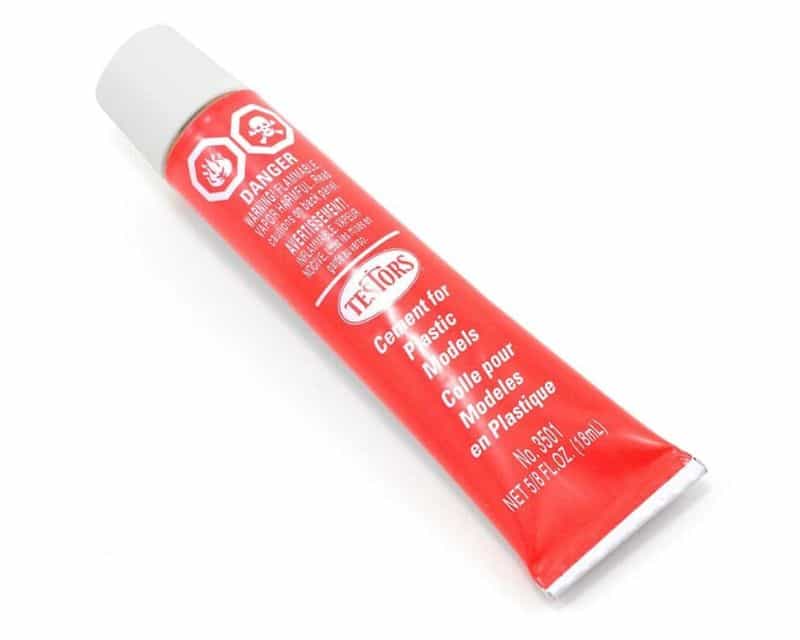
If you’re looking to get Testor’s plastic model cement and haven’t yet, maybe give this a try instead of regular plastic cement. I recommend this especially, if you do your mini hobby work in a place that might be accessible to young children, pets, or simply a place that you don’t want to stink up with harmful fumes and vapors.
A lot of the stuff we use in our miniature hobby can be bad for you and your household. Why add more risk?
Other key features:
- This is a 5/8 Oz. Tube of Non-Toxic Cement for Plastic Models from Testors
- Safe cement for plastic models
- Joins polystyrene to polystyrene
- Useful for repairing household items made of polystyrene or ABS plastics
This is the overkill epoxy. It’s awesome!
I purchased this stuff years ago when most of my pewter miniatures would fall apart too easily with super glue. I just got frustrated and went for the strongest stuff I could find at my local hardware shop (Home Depot).
JB Weld is the epoxy you use when you want to repair a crack in your car’s engine block, or a leaking hot water pipe. I’ve personally glued together a small tear in my car’s bumper with this stuff.
As a metal glue, JB Weld is well-known, and the preferred epoxy for bonding metal parts.
JB Weld is marketed as the “cold weld”, because of its permanence and durability. It can withstand a literal ton of pulling force (up to 3960 PSI) and can remain intact in temperatures you might use on a frying pan (more than 500F). Ultimately, the adhesive has steel material in it, and has a stronger bond in some cases than “real” heat-fuse welding techniques.
I personally don’t use it much anymore because it takes up to 24 hours to cure. That’s too long for most applications I would need in assembling miniatures. I don’t like waiting…but, if you’re someone who wants something that you assemble to stay together for a long, long time, JB Weld might be it.
In any case, it’s great to have as a backup repair tool in your home. This stuff can help you fix anything.
Other key features:
- The Original Cold Weld two-part epoxy system that provides strong, lasting repairs to metal and multiple surfaces
- Perfect for household, automotive, marine and craft uses
- JB Weld was developed as an alternative to torch welding
- Designed to be effective in extreme environments, once it sets, it creates a permanent bond stronger than steel
- Mixed at a ratio of 1:1, it forms a permanent bond and can be shaped, tapped, filed, sanded and drilled after curing
- At room temperature, J-B Weld sets in 4-6 hours to a dark grey color
- Versatile and dependable: this epoxy has a tensile strength of 3960 PSI & sets overnight
- It can withstand temperatures up to 550ºF when cured.
- Great for use on brick, concrete, metal, fiberglass & more
At the end of the day, I ended up using this for most of my epoxy needs. Unlike the BSI two part epoxy (not on my list), it is more available in my local area in hardware stores and arts and crafts shops. Z-poxy is like every other two part epoxy in that you mix the two parts together in a 1:1 ratio and apply it.
For miniatures, I’ve used this stuff to glue down large heavy models to bases. I’ve closed up gaps to make water effect ponds and muddy pools.
The cured epoxy has some flex to it, which is good because it helps absorb some of the stresses that might be placed on the model. For model kit building for RC hobbies where models undergo repetitive stress, e.g., planes, off-road trucks, boats, etc., the cured epoxy helps keep the joints tight and secure. The cured epoxy also helps to waterproof the model.
Additionally, the bonded parts with this epoxy are resilient to all sorts of solvents. I know because I’ve put models into paint stripper (denatured alcohol) and almost all the super-glued bonds broke except for the ones where I used this epoxy.
This version cures in about 15 minutes, which I found is the perfect time for me to use it all without losing too much to waste.
On large models, I make up small batches and work my way through the assembly. And, I only make enough that I know I can use up in that 15 minute timeframe.
As with all the other epoxies, before the adhesive has cured, you can clean up any excess with rubbing alcohol.
Z-proxy, I’ve discovered, is great for 3D printing applications. I’ve used it to assemble PLA printed parts, as well as use it as a smoothing agent. I apply a thin coat of this stuff over a 3D printed part and it fills in the layer lines that often plague FDM prints. Once hardened, it takes primer and paint very well.
Another neat trick I found was that because it dries clear, it can simulate water effects really well. I’m sure with some experimentation, you could probably come up with other creative uses for this transparent epoxy.
Other key features:
- Cures completely clear!
- Easy to sand and has excellent gap filling characteristics
- Z-Poxy is specially formulated to bond to fiberglass, wood, metals, and plastics
- Resistant to shock and solvents
- Non-brittle, non-shrinking
- Produces a tough permanent bond in just 30 minutes
Summary
| Image | Product | Type |
|---|---|---|
 | Cyanoacrylate | |
 | Cyanoacrylate | |
 | Bob Smith Industries BSI-133H Insta-Cure+ Gap Filling Super Glue | Cyanoacrylate |
 | Professional Grade Cyanoacrylate (CA) “Super Glue” by Glue Masters | Cyanoacrylate |
 | Plastic cement | |
 | Plastic cement | |
 | Plastic cement | |
 | Plastic cement | |
 | Two-part epoxy | |
 | Two-part epoxy |
I’m always looking for new things to try out in the miniature hobby space. When it comes to glues and adhesives for assembling miniatures and model kits, there are a lot of options. My default when I’m unsure what to use for my project is to reach for super glue. For more specialized applications, you’ll learn as I did through experience that other types of bonds may require a different approach.
I hope this article helped give you more information about finding the best glue for your needs!
Have you found a best glue or adhesive application that works for your needs? I know scratch builders have a lot of insight into this.
Let me know in a comment below!
Subscribe through email or follow us on Facebook and Instagram.
Thanks for reading! 😃



Tangible Day on YouTube (Miniatures and More!)

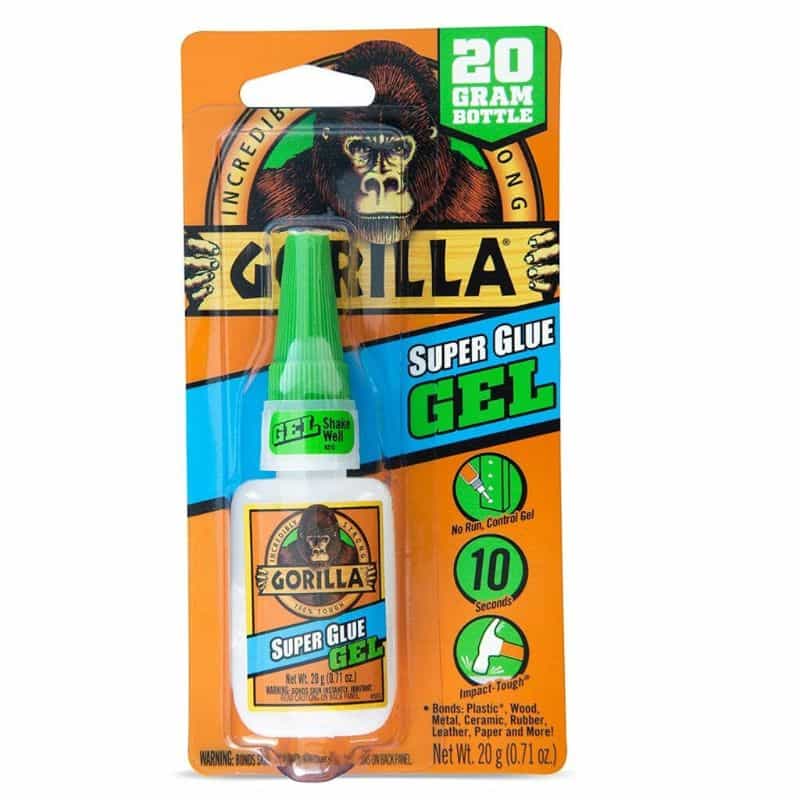
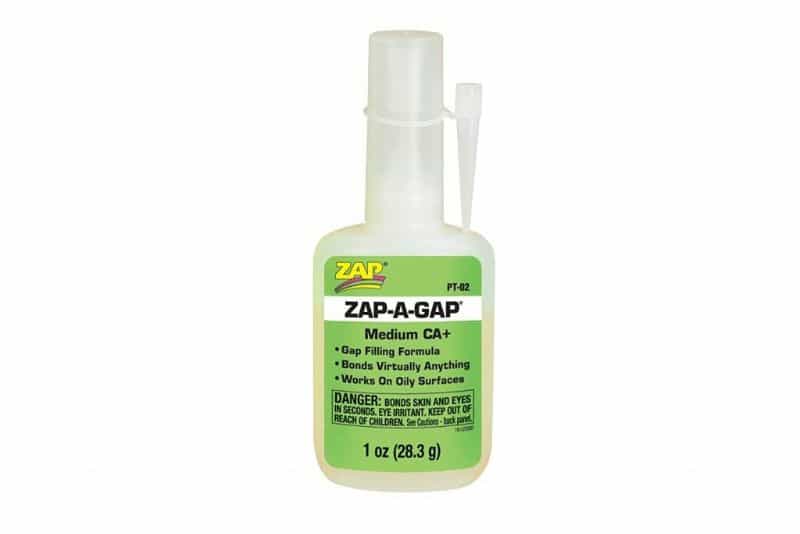
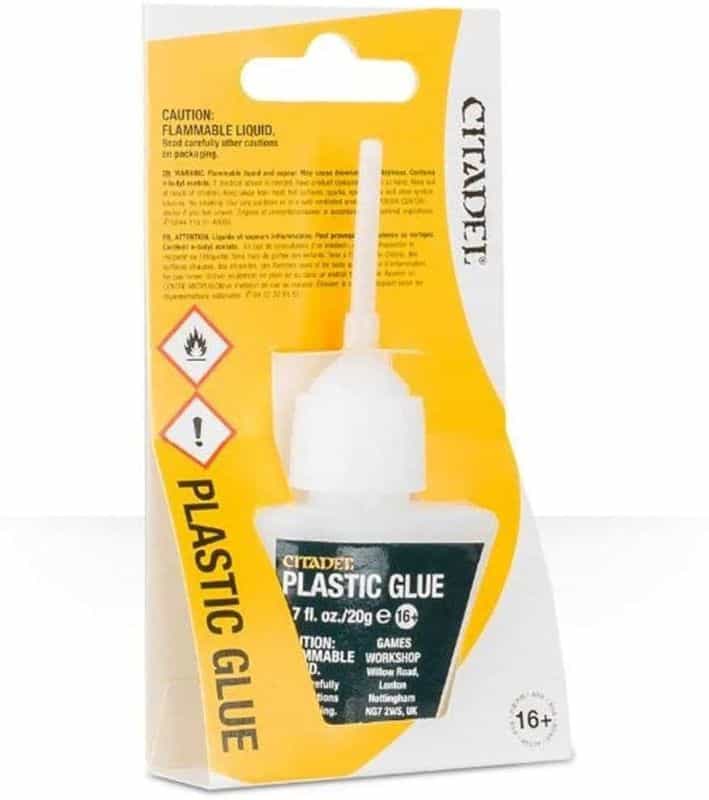
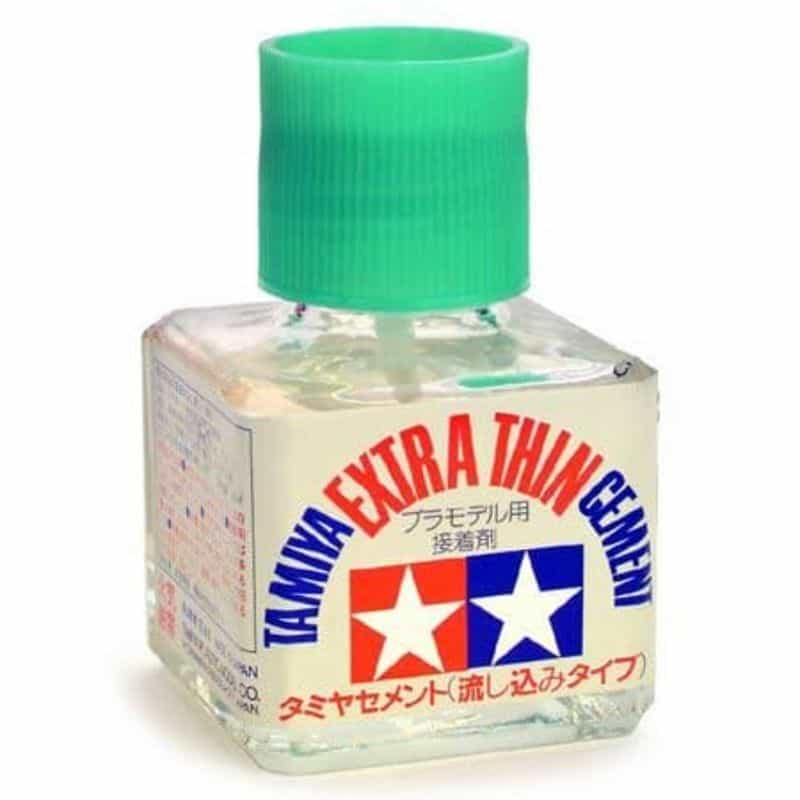
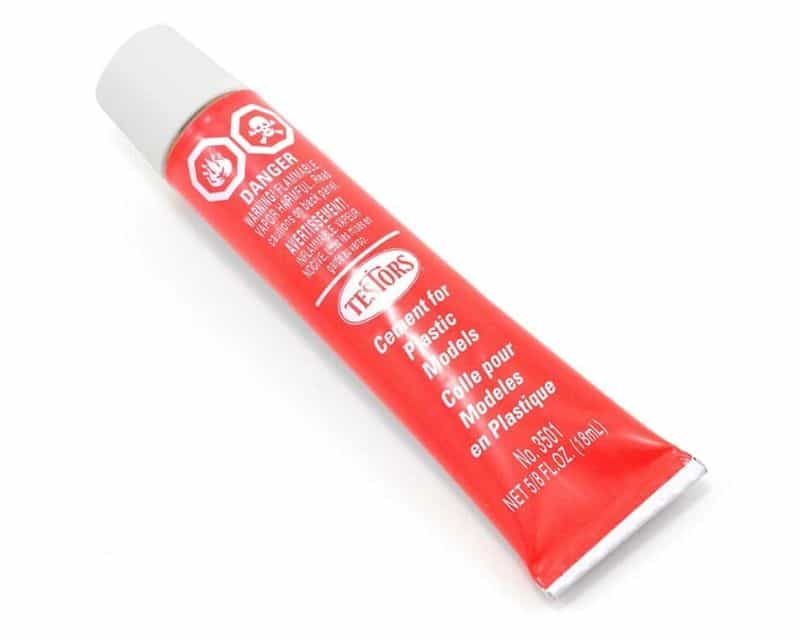
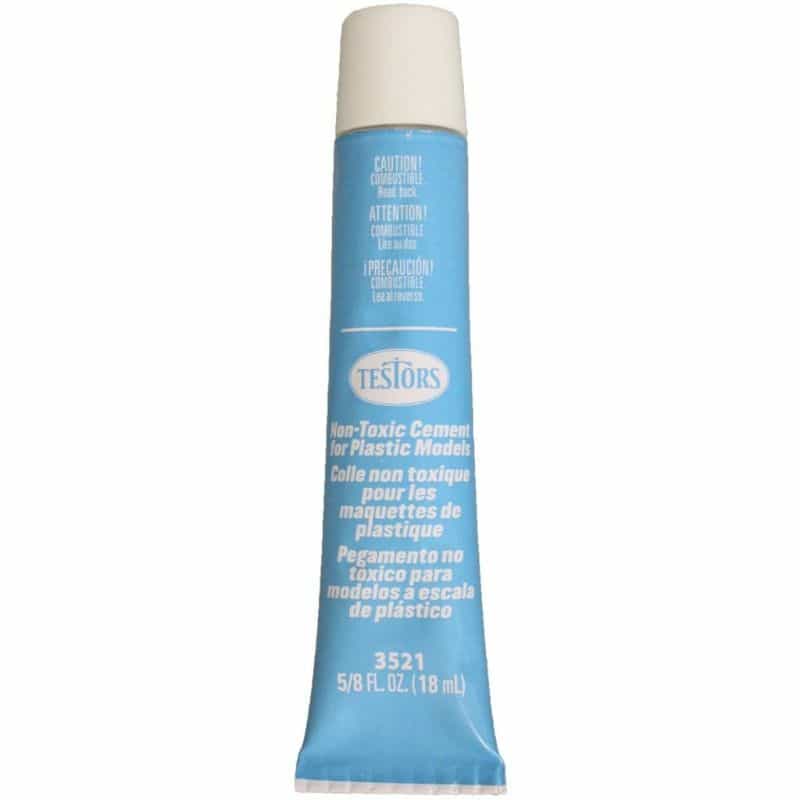
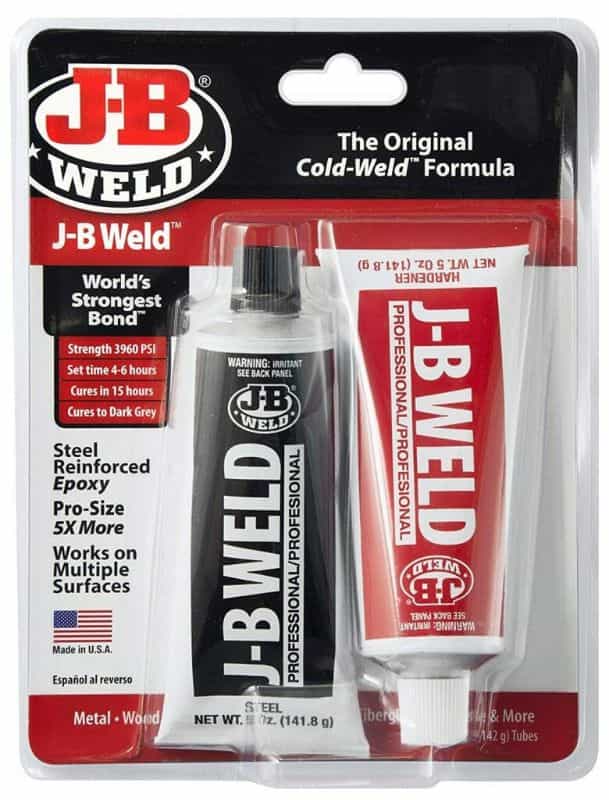
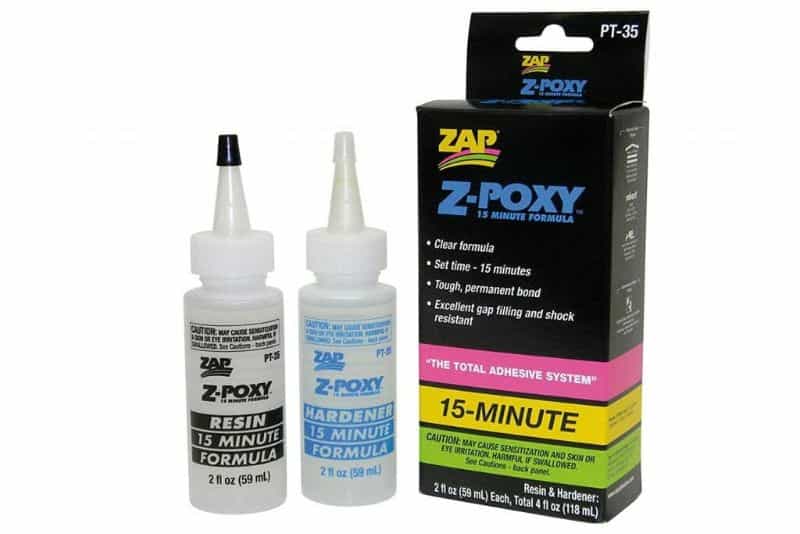
How did you secure the model parts when using the steel reinforced epoxy?
I use painters tape or use soldering holders. https://tangibleday.com/10-helping-hands-for-assembling-and-painting-miniatures/
excelent easy to read/follow for even me 80 year old numpty, being only a rare occasional repairer of broken things i found your research realy self explanitory, thanks for sharing your knowledge
Thank you! I’m glad it helps and was clear to follow. I am always tweaking things to improve these posts.
Whats the best glue to bond a miniature resin to a plastic keycap?
Two part epoxy will be the strongest and most durable, especially if you’re going to literally punch those keys 😉 Super glue will be the easiest and effective – but will be brittle over time.